|
I
was in Iloilo for 1 whole day, 2 one-half days and
1 one-fourth day, yet, it felt like I simply
whizzed by this province. It wasn't unusual that
my friends and I would hop off from one
municipality to the next and see what it has to
offer, but my whole Iloilo experience seemed
incomplete. Maybe because Iloilo boasts more of
historical landmarks than natural tourist spots
and we have not covered all these landmarks during
our stay except for the century-old Catholic
churches. I'm not a history buff nor so much into
antiques and other old stuff, so I guess, that
explains my "incomplete" feeling... I
was hoping to see falls, beaches, caves, etc. so
Iloilo can make its mark on me. [Oh, but it did
left a mark... just read on.] Just the same,
here's a brief rundown of the places my friends
and I went to last April 7, 8, 9 & 11, 2004.
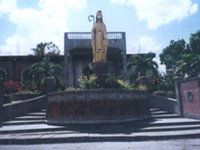 Our
first Iloilo municipality tour is Janiuay.
Although we have seen the magnificent stone arches
of Janiuay Cemetery before we reached the church,
we were unable to stop by and take pictures of it.
Were we too tired to make the stopover? Or were we
too lazy? [Sigh!] Whatever our reasons were at
that time, I surely regret that none of us
insisted on going back there. The 3 stone arches
were such a spectacular view and it was such a
shame that we didn't have any souvenirs of it. Our
first Iloilo municipality tour is Janiuay.
Although we have seen the magnificent stone arches
of Janiuay Cemetery before we reached the church,
we were unable to stop by and take pictures of it.
Were we too tired to make the stopover? Or were we
too lazy? [Sigh!] Whatever our reasons were at
that time, I surely regret that none of us
insisted on going back there. The 3 stone arches
were such a spectacular view and it was such a
shame that we didn't have any souvenirs of it.
We
went directly instead to the Janiuay Church which
was named San Julian de Cuenca Parish. The church
is quite new (or recently renovated), but the
ruins of the older church was still standing
beside the new one. Although most of the parts of
the older church have been destroyed, it still
looked magnificent,
just like some of the ruined parts of the Fort
Santiago in Manila.
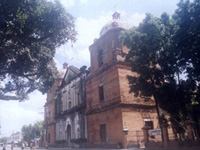 Next,
we went to the San Nicolas de Tolentino Parish in
Cabatuan. This neo-classical church was built in
the early 1880's and every side of the church is a
facade in itself. [So it's really up to you to
decide if my picture here of the church is the
front.] We went up to the not-so-high belltower to
take a look at its bells. Of course, the bells
weren't much compared to the ones we saw in
Pan-ay, Capiz. Next,
we went to the San Nicolas de Tolentino Parish in
Cabatuan. This neo-classical church was built in
the early 1880's and every side of the church is a
facade in itself. [So it's really up to you to
decide if my picture here of the church is the
front.] We went up to the not-so-high belltower to
take a look at its bells. Of course, the bells
weren't much compared to the ones we saw in
Pan-ay, Capiz.
 Our
next stop was the Church and Convent of Santa
Barbara in [where else?] Santa Barbara. Seeing
this church felt like we had a deja vu of some
sort as it looked a lot like the St. Isidore
Labradore Convent in Lazi, Siquijor. I was the
only one among our group who was able to go inside
the church as they were too strict on dress codes.
Most of us were wearing sando, low necklines and
shorts -- the very clothes not allowed within the
church. Our
next stop was the Church and Convent of Santa
Barbara in [where else?] Santa Barbara. Seeing
this church felt like we had a deja vu of some
sort as it looked a lot like the St. Isidore
Labradore Convent in Lazi, Siquijor. I was the
only one among our group who was able to go inside
the church as they were too strict on dress codes.
Most of us were wearing sando, low necklines and
shorts -- the very clothes not allowed within the
church.
 Next, we went to the ever famous and my personal favorite KA-TED-RAL, the Cathedral of Nuestra Seņora dela Candelaria in Jaro. This cathedral houses the statue of Nuestra Seņora dela Candelaria, which was said to be growing in size. In front of the church was the Jaro Belfry, a magnificent free-standing edifice across the main street and one of the remaining belfries in the country today that stands apart from the church. This church has definitely left its mark on me, not because of its exquisite beauty, but because of the experience I had with a Baranggay Tanod guarding the statue of Nuestra Seņora dela
Candelaria. Next, we went to the ever famous and my personal favorite KA-TED-RAL, the Cathedral of Nuestra Seņora dela Candelaria in Jaro. This cathedral houses the statue of Nuestra Seņora dela Candelaria, which was said to be growing in size. In front of the church was the Jaro Belfry, a magnificent free-standing edifice across the main street and one of the remaining belfries in the country today that stands apart from the church. This church has definitely left its mark on me, not because of its exquisite beauty, but because of the experience I had with a Baranggay Tanod guarding the statue of Nuestra Seņora dela
Candelaria.
 It has always been my habit to know the name of a church that I have visited for the first time instead of merely referring to it as the church of some place. I knew that this church was popularly and simply called Jaro Cathedral, but I still wanted to know its real name. So after all our picture takings with the church and the belfry, I asked this Baranggay Tanod what the church of the name was. He answered "katedral." Of course, I knew it was the cathedral. So, I asked him again and clarified that I was actually asking for the specific name of the church making sure I used the simplest Tagalog words I can think of so I can be understood. Looking at me straight in the eye as if I'm some moron who doesn't know what he said earlier means, the Baranggay Tanod answered again "KA-TED-RAL." Yes, it was said with too much conviction, stress and was syllabicated. I get the point. For him, I was indeed a moron who doesn't know what "katedral" means. [Sige na nga, KA-TED-RAL na
itu!!!] It has always been my habit to know the name of a church that I have visited for the first time instead of merely referring to it as the church of some place. I knew that this church was popularly and simply called Jaro Cathedral, but I still wanted to know its real name. So after all our picture takings with the church and the belfry, I asked this Baranggay Tanod what the church of the name was. He answered "katedral." Of course, I knew it was the cathedral. So, I asked him again and clarified that I was actually asking for the specific name of the church making sure I used the simplest Tagalog words I can think of so I can be understood. Looking at me straight in the eye as if I'm some moron who doesn't know what he said earlier means, the Baranggay Tanod answered again "KA-TED-RAL." Yes, it was said with too much conviction, stress and was syllabicated. I get the point. For him, I was indeed a moron who doesn't know what "katedral" means. [Sige na nga, KA-TED-RAL na
itu!!!]
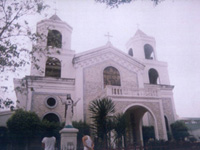 Our 5th Iloilo church was the one in Mandurriao called the Parish of the Spousal of our Lady. The church doesn't look historic at all, but we still went down anyway to make sure we have enough churches to complete our Visita
Iglesia. Our 5th Iloilo church was the one in Mandurriao called the Parish of the Spousal of our Lady. The church doesn't look historic at all, but we still went down anyway to make sure we have enough churches to complete our Visita
Iglesia.
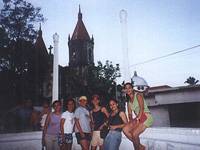 Our next church stop was nothing at all like the Mandurriao Church. If I felt that the previous church lacked history, this one in Molo is a history in itself. St. Anne Parish is a Gothic Renaissance church built sometime in.... [Ooops! I didn't get the year.] Personally, this magnificent structure seemed more like a castle than a church at a distance. Sad to say, it was hard to take a picture of the entire church as the plaza at its front were covered with trees, plus a lot of people were gathered on the main street since a Lenten procession was about to start then. Our next church stop was nothing at all like the Mandurriao Church. If I felt that the previous church lacked history, this one in Molo is a history in itself. St. Anne Parish is a Gothic Renaissance church built sometime in.... [Ooops! I didn't get the year.] Personally, this magnificent structure seemed more like a castle than a church at a distance. Sad to say, it was hard to take a picture of the entire church as the plaza at its front were covered with trees, plus a lot of people were gathered on the main street since a Lenten procession was about to start then.
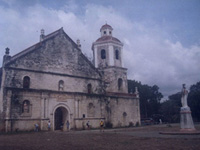 We
also went to San Joaquin, the last municipality in
Iloilo before the province of Antique. Personally,
I wanted to go to this place to take a look at the
historic Sirawagan River which was said to be the
site where the legendary 10 Bornean datus landed
in the 13th century. Since there was also an old
church here, we decided to look for it first
before the landing site [which no one in San
Joaquin seems to know]. We
also went to San Joaquin, the last municipality in
Iloilo before the province of Antique. Personally,
I wanted to go to this place to take a look at the
historic Sirawagan River which was said to be the
site where the legendary 10 Bornean datus landed
in the 13th century. Since there was also an old
church here, we decided to look for it first
before the landing site [which no one in San
Joaquin seems to know].
The
San Joaquin Church was named [how creative!] the
Parish of San Joaquin. Its facade boasts off a
bas-relief depicting the historic battle between
Christians and Moors in 1859, known as the Battle
of Tetuan in Morocco. You may think of it as a
Miag-ao Church look-a-like, but with less grandeur
and maintenance.
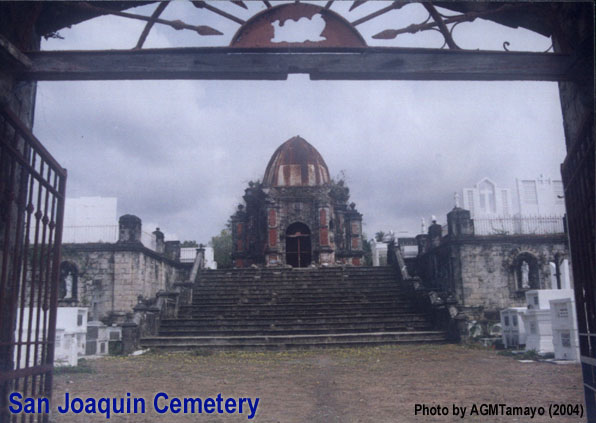 Next,
we tried looking for the Sirawagan River but we
only got disappointed as the river turned out to
be a soon-to-be dry riverbed. Next,
we tried looking for the Sirawagan River but we
only got disappointed as the river turned out to
be a soon-to-be dry riverbed.
Still
in San Joaquin, we also dropped by the San Joaquin
Cemetery. The cemetery's gate had a stone arch
which looks like the ones in Janiuay Cemetery,
only smaller. Inside, there was a 20-step stone
staircase and a hexagonal chapel on top of it.
Our
next destination was not a church, but a
university. We passed by the University of the
Philippines in the Visayas and went down in front
of the Oblation for picture taking. [Don't worry,
it was no different from the one in Diliman,
Quezon City.] Right after this, we headed straight
to the famous Miag-ao Church.
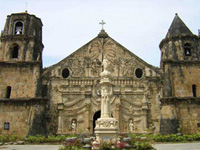 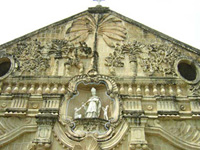 The
Church of Santo Tomas de Villanueva in Miag-ao was
built in 1768. The facade had a bas-relief with a
native botanical motif, reminiscent of the Aztec
Art. It was one of the 4 Baroque churches in the
Philippines included in the UNESCO's Heritage List
and was declared a national landmark in 1973. Yes,
the church was indeed grand and beautiful. [And
for anyone who would be going to Iloilo, I suggest
that you include this church in your tour or it
wouldn't seem like you've been to Iloilo at all.] The
Church of Santo Tomas de Villanueva in Miag-ao was
built in 1768. The facade had a bas-relief with a
native botanical motif, reminiscent of the Aztec
Art. It was one of the 4 Baroque churches in the
Philippines included in the UNESCO's Heritage List
and was declared a national landmark in 1973. Yes,
the church was indeed grand and beautiful. [And
for anyone who would be going to Iloilo, I suggest
that you include this church in your tour or it
wouldn't seem like you've been to Iloilo at all.]
The
last 2 churches that we went to were the San
Nicolas de Tolentino Parish in Guimbal and the St.
John of Sahagun Parish in Tigbauan. These 2 were
still good-looking churches but after seeing the
one in Miag-ao, I knew I had enough churches for
this Holy Week.
|